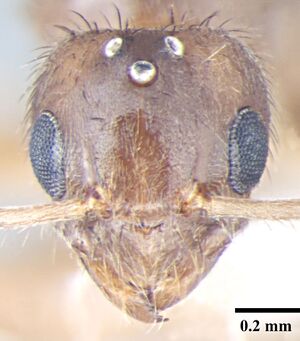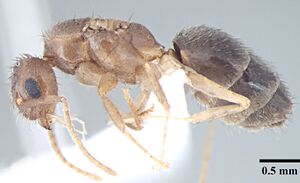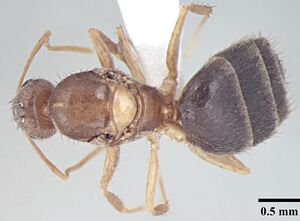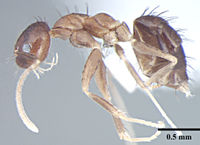Nylanderia smythiesii
| Nylanderia smythiesii | |
|---|---|

| |
| Scientific classification | |
| Kingdom: | Animalia |
| Phylum: | Arthropoda |
| Class: | Insecta |
| Order: | Hymenoptera |
| Family: | Formicidae |
| Subfamily: | Formicinae |
| Tribe: | Lasiini |
| Genus: | Nylanderia |
| Species: | N. smythiesii |
| Binomial name | |
| Nylanderia smythiesii (Forel, 1894) | |
This species is generally in distribution in low altitude areas of Northwest India. Nests can be found easily underneath stones and leaf litter whilst foraging workers are fairly frequent on trees and fallen trunks (Wachkoo and Bharti 2014).
Identification
Distinguished by the oval shape of head, and smooth and shiny cuticle without any pubescence.
Keys including this Species
Distribution
Known from low altitude areas of Northwest India.
Latitudinal Distribution Pattern
Latitudinal Range: 32.7009° to 30.2483°.
| North Temperate |
North Subtropical |
Tropical | South Subtropical |
South Temperate |
- Source: AntMaps
Distribution based on Regional Taxon Lists
Oriental Region: India (type locality).
Distribution based on AntMaps
Distribution based on AntWeb specimens
Check data from AntWeb
Countries Occupied
| Number of countries occupied by this species based on AntWiki Regional Taxon Lists. In general, fewer countries occupied indicates a narrower range, while more countries indicates a more widespread species. |

|
Estimated Abundance
| Relative abundance based on number of AntMaps records per species (this species within the purple bar). Fewer records (to the left) indicates a less abundant/encountered species while more records (to the right) indicates more abundant/encountered species. |

|
Biology
Castes
Queen
  
| |
| . | |
Male
  
| |
| . | |
Nomenclature
The following information is derived from Barry Bolton's Online Catalogue of the Ants of the World.
- smythiesii. Prenolepis smythiesii Forel, 1894c: 410, fig. 5 (q.m.) INDIA. Combination in Paratrechina (Nylanderia): Emery, 1925b: 220; in Nylanderia: LaPolla, Brady & Shattuck, 2010a: 127.
Unless otherwise noted the text for the remainder of this section is reported from the publication that includes the original description.
Description
Worker
Wachkoo and Bharti (2014) - HL 0.60–0.68; HW 0.47–0.56; EL 0.14–0.19; SL 0.70–0.77; PW 0.37–0.43; PrFL 0.56–0.64; PrFW 0.13–0.17; WL 0.73–0.88. Indices: CI 77.68–82.26; SI 137.25–151.16; REL 23.64–27.42 (n = 8).
Wachkoo and Bharti (2015) - HL 0.60-0.68 mm; HW 0.47-0.56 mm; EL 0.14-0.19 mm; SL 0.70-0.77 mm; PW 0.37-0.43 mm; PrFL 0.56-0.64 mm; PrFW 0.13-0.17 mm; WL 0.73-0.88 mm. Indices: CI 77.68-82.26; SI 137.25-151.16; REL 23.64-27.42 (n = 20).
Head broadly oval; distinctly longer than wide, slightly wider posteriorly, lateral margins convex, posterior margin shallowly concave to gently convex with rounded posterolateral corners. Clypeus subcarinate in the middle; anterior clypeal margin weakly concave. Mandibles with six teeth. Eyes oval, weakly convex, covering onethird of lateral cephalic margin; three small ocelli present. Antennae long, scapes surpass the posterior margin by two-fifths their length.
Metanotal groove strongly developed, in lateral view interrupts the regular promesonotal convexity from propodeum; metanotal area long. Dorsal face of propodeal not higher than remainder of the notum, gently rounded; declivity steep.
In lateral view, petiole triangular with dorsum of the petiole well below the dorsum of propodeum, rounded above with posterior face much longer than anterior face.
Overall cuticle very smooth and shiny. Pubescence on body very sparse; almost entirely absent. Scapes and legs covered with abundant erect setae, and a very fine layer of pubescence. Erect setae of varying length cover head, pronotum, mesonotum and gaster. Setae very densely spaced on head and gaster.
Head brown; gaster brown to black; mesosoma, antennae and legs yellowish brown.
Queen
Wachkoo and Bharti (2014) - HL 0.84; HW 0.80; EL 0.30; SL 0.93; PrFL 0.82; PrFW 0.23; WL 0.88. Indices: CI 95.59; SI 115.82; REL 35.71 (n = 1).
Generally matches worker description, with modifications expected for caste and the following differences: Body covered with dense pubescence and fine punctulae. Head subtriangular, posterior margin concave; in lateral view, petiole with flat dorsum. Head yellow brown, gaster brown, a shade lighter than in workers.
Male
Wachkoo and Bharti (2014) - HL 0.52–0.55; HW 0.42–0.46; EL 0.22–0.24; SL 0.66–0.72; PrFL 0.56– 0.62; PrFW 0.13–0.15; WL 0.75–0.85. Indices: CI 80.00–85.42; SI 146.34–157.89; REL 41.67–44.44 (n = 8).
Head broadly oval; longer than wide; eyes large, subglobulose, projecting beyond head outline in full-face view; three prominent ocelli present. Antennae 13 segmented, filiform, scapes long, surpass posterior margin by about half their length. Mandibles slender, curved strap like with prominent, pointed apical and a small preapical tooth, remainder of masticatory margin smooth, without any teeth or denticles. Basal angle rounded, indistinct and seamlessly blends into inner mandibular margin.
Mesosoma enlarged to accommodate flight muscles; in lateral view scutum and scutellum flat; propodeum indistinct, lower than remainder of notum with very short dorsal face and long declivitous face.
Petiole as in worker; gaster elongated.
Parameres paddle-shaped, rounded apically, turning strongly inward toward midline of body posteriorly, as long as digiti; long setae extending off of parameres. Cuspi long and tubular reaching digiti dorsally; bent toward digiti; digiti weakly anvil-shaped; directed upward and covered with short peg-like teeth; digiti visible in lateral view. Penis valves projecting barely past parameres.
Sculpture, vestiture and color as in worker caste.
References
- Emery, C. 1925d. Hymenoptera. Fam. Formicidae. Subfam. Formicinae. Genera Insectorum 183: 1-302 (page 220, Combination in Paratrechina (Nylanderia))
- Forel, A. 1894c. Les Formicides de l'Empire des Indes et de Ceylan. Part IV. J. Bombay Nat. Hist. Soc. 8: 396-420 (page 410, fig. 5 queen, male described)
- Wachkoo A. and Bharti, H. 2014. First description of the worker caste of Nylanderia smythiesii (Hymenoptera: Formicidae). Biodiversity Data Journal 2: e1163. doi:10.3897/BDJ.2.e1163
- Wachkoo, A. A. and Bharti, H. 2015. Taxonomic review of ant genus Nylanderia Emery, 1906 (Hymenoptera: Formicidae) in India. Journal of Asia-Pacific Entomology. 8:105-120.
References based on Global Ant Biodiversity Informatics
- Dad J. M., S. A. Akbar, H. Bharti, and A. A. Wachkoo. 2019. Community structure and ant species diversity across select sites ofWestern Ghats, India. Acta Ecologica Sinica 39: 219–228.
- Forel A. 1894. Les Formicides de l'Empire des Indes et de Ceylan. Part IV. J. Bombay Nat. Hist. Soc. 8: 396-420.
- Forel A. 1906. Les fourmis de l'Himalaya. Bulletin de la Société Vaudoise des Sciences Naturelles 42: 79-94.
- Wachkoo A. A., and H. Bharti. 2014. First description of the worker caste of Nylanderia smythiesii (Hymenoptera: Formicidae). Biodiversity Data Journal 2: e1163 doi: 10.3897/BDJ.2.e1163

